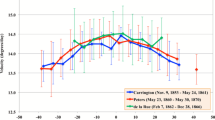Abstract
Digitized Mount Wilson sunspot data from 1917 to 1985 are analyzed to examine group areas as a function of latitude distance (ξ) from the central latitude of activity in each hemisphere. On average these group areas are larger for the smallest values of ¦ξ¦. The effect is similar to that seen for the magnetic fields of active regions (Howard, 1991). It is concluded that this is fundamentally a ξ dependence, and not a latitude dependence. The suggestion is made that the cause of this effect is the influence of large-scale convective motions on the rising flux tubes that make up the active regions. The smaller flux tubes (spot groups) are more easily displaced in latitude during their ascent to the surface by this velocity field than are the larger flux tubes.
Similar content being viewed by others
References
Howard, R. F.: 1991, Solar Phys. 131, 259.
Howard, R. F., Gilman, P. A., and Gilman, P. I.: 1984, Astrophys. J. 283, 373.
Author information
Authors and Affiliations
Additional information
Operated by the Association of Universities for Research in Astronomy, Inc., under Cooperative Agreement with the National Science Foundation.
Rights and permissions
About this article
Cite this article
Howard, R.F. Sunspot group areas and the latitude distance from the average latitude of activity. Sol Phys 135, 339–342 (1991). https://doi.org/10.1007/BF00147505
Received:
Issue Date:
DOI: https://doi.org/10.1007/BF00147505




